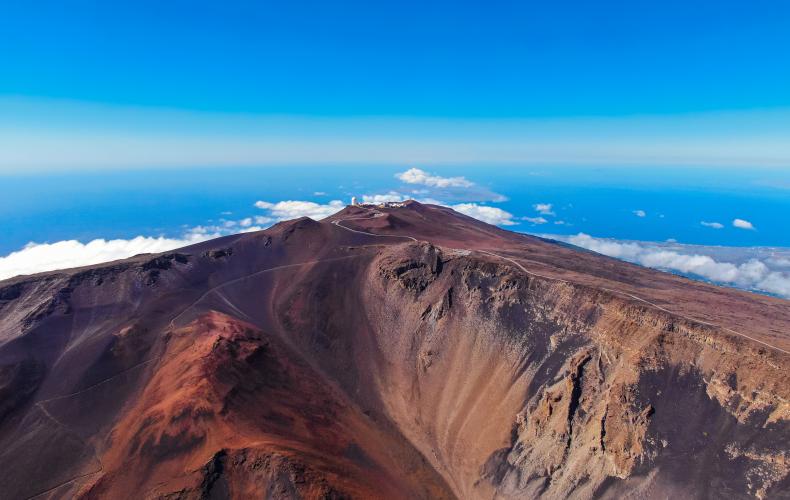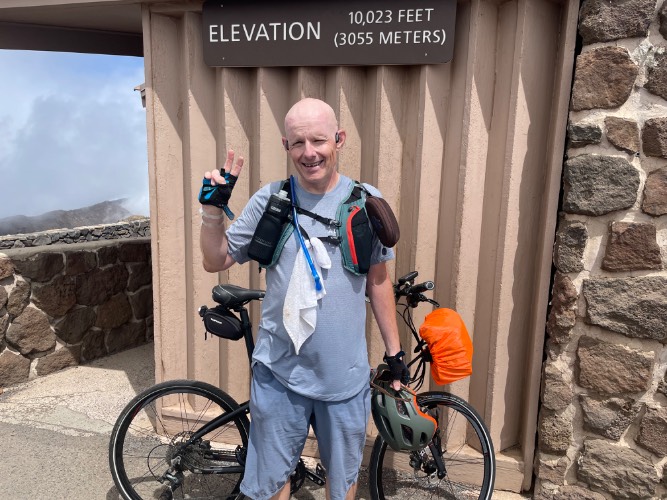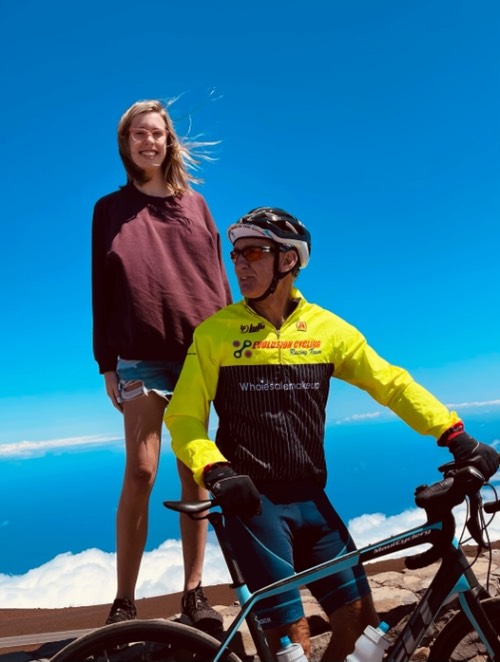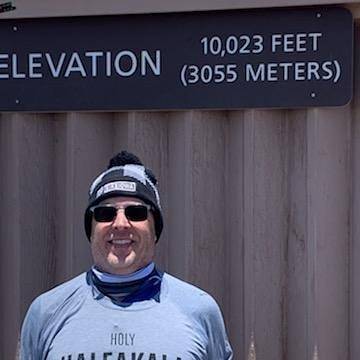![Cycling Haleakala Volcano PJAMM Cycling - Haleakala Crater and summit - drone photo]()
Cycling Haleakala Volcano, Maui, Hawaii
Aerial Sphere Photo:
Center - Haleakala Crater; center right - Summit and approach to summit
The Haleakala volcano route, located within Haleakala National Park in Maui, is a US Top 10 Most Epic Bike Climb.
Travel Trip: If you are interested in traveling to Maui for a cycling or recreational adventure, be sure to consider PJAMM’s Travel App and our preloaded Maui Adventure.
From the incomparable US cycling author, John Summerson:
“Haleakala is a giant and classic road bike climb that is among the most difficult in the world. From the corner of Hana Highway and Baldwin Avenue in the small town of Paia on the island of Maui, head up an easy and gradually increasing grade for 7.1 miles to the town of Makewao. At the intersection with Makewao Avenue go straight up the hill over a short steep stretch as Baldwin Avenue becomes Olinda (do not turn right on Makewao Ave as some suggest. This adds 1.5 miles of flat riding within much more traffic). Climb for one mile on Olinda and turn right on Hanamu for another flat mile to the junction of Route 377. Turn left on fairly shallow 377 for ~five miles to its junction with Route 378. Turn left on 378 which will take you the rest of the way up the mountain (only 7,000 feet to go!).
![]()
Start the climb at sea level and finish 10,000’ later!!
The road soon begins to travel through big switchbacks up the hill, endless climbing it can seem, crossing four cattle guards along the way. Just beyond the fourth one you come to the National Park entrance gate where you must stop and pay $5 (yes, even bikes) [PJAMM note: $15 2021]. The Visitor’s Center is one mile further up the road (water). The terrain becomes increasingly rocky and volcanic at this point with great views of the distant Pacific Ocean on a clear day. Continue climbing through more shallow grade and soon you are riding through a moonscape of black lava. Almost to the top you reach the upper Visitor’s Center where you turn right. The climb finishes at the shelter at over 10,000 feet (ride up the paved trail to the very top).
This climb is so long so make sure you take plenty of food and fluids. The descent is wild and long and can be cold (and wet) so carry what you might need (you may see groups on the way up who are only descending the hill). There is an annual race on Haleakala as well.” (This quote is presented with the approval of John Summerson, from his book, The Complete Guide to Climbing (by Bike), 2nd Edition, pg. 176.)
Before traveling to Hawaii for your Haleakala cycling adventure, be sure to rely on our list of Things to Bring on a Cycling Trip, and use our interactive checklist to ensure you don't forget anything.
What You Should Know About Biking/Climbing Haleakala:
First, and foremost . . .
![]()
This is one amazing place to ride your bike 👍🚲🌋🚲👍
There’s nothing quite as incredible as road biking Maui. Haleakala is an epic and challenging volcanic climb that takes you into Haleakala National Park on one of the most beautiful of Hawaiian Islands. The 35 mile climb from Paia to the Haleakala Lookout and the Visitor Center (located half a mile below the lookout) shares its first eight miles with another US Top 100 Climb: Baldwin Avenue/Olinda Road. From Paia, a small town of just over 2,000 with several restaurants and small shops to occupy your time pre- or post-ride, you’ll ride eight miles on Baldwin (which turns into Olinda Road at Makawao Avenue at the seven mile mark), turn right onto Hanauma where you’ll ride for one mile, then turn left onto Haleakala Highway where you’ll be for the remaining 26.8 miles to the top.
![]()
On top of the world -- six times up and it never gets old. 👍🚴🗻🚴👍
More on Paia Town:
This Hawaiian town is the perfect spot to immerse yourself in Maui’s North Shore surf culture. Paia solidified itself as a Bohemian Mecca when it became a landing place for many of the 1960’s Counterculture “hippies” (hey, that’s my era, by the way!) once they left San Francisco. Now considered the “incarnation of Hawaii small town charm,” (Paia Town) you can enjoy all sorts of experiences in this unique town -- from yoga studios and coffee shops to health food stores, delicious seafood, and world class surfing -- you won’t regret making a little extra time on your trip for a stop in Paia.
![Begin Haleakala climb in Paia Start of our Haleakala Volcano bike climb in Paia, Maui]()
Start the climb in Paia.
When to Climb Haleakala by Bike:
The climb begins in Paia, a very dry area. During the winter months (November through February) there is on average only a 20% chance of rain. The lowest rainfall month is June, followed by July. The temperature can be a factor at the at the higher levels, so be prepared for that. There is no chilly time to begin a climb in Paia (low-average high is 80 degrees in January and the high-average high is 87 degrees in August). The warmest months at the top of Haleakala are June through August and the lowest rainfall happens in May through August. Factoring in all these meteorological variables, we suggest June as the best month to climb Haleakala. Of the five times PJAMM Cycling has completed this climb, three have been in June, and all three of these climbs were fine from bottom to top. But, 10,000’ up from the ocean it can be quite chilly, particularly so in the non-summer months.
![Weather on Haleakala Start of our Haleakala Volcano bike climb in Paia, Maui]()
We can experience all kinds of weather along our 35 mile climb
Check PJAMM’s Forecast (on the climb card above right top of this page) in advance.
How to Climb Haleakala by Bike:
Train well because this is is one of the hardest climbs in the world (#2 US/#35 World) at 36 miles and 10,331 feet gained at a 5.3% average grade. The road is paved to the top and never too steep -- the steepest half mile is the last stretch to the summit which is 9%, but at 10,000 feet which makes it much harder than 9%. Unlike Mauna Kea and Mauna Loa on the Big Island, there are two spots to pick up food and drink along the Haleakala route so you need not over-stock from the start. Makawao is six miles from start and has markets and bakery, and the Kula Market is 13.5 miles up on Highway 377 (down a slight hill on the right, not readily visible from the road -- next to Kula Lodge & Restaurant).
![Halekala Volcano - Baldwin Ave Start of our Haleakala Volcano bike climb in Paia, Maui]()
On Baldwin Ave for the first seven miles.
![Haleakala Volcano - Hwy 377 Riding by bike past the Haleakala park sign]()
Highway 377 for 5 miles at 5.3%.
![]()
Even the highways are beautiful in Hawaii!
![]()
![]()
Highway 377 11 miles from the start.
It’s not uncommon to encounter rainbows in Hawaii, as is frequently evidenced along this climb.
![Haleakala Park Sign Riding by bike past the Haleakala park sign]()
Last 20 miles are on Highway 378 (Haleakala Highway).
At mile 9.2 we turn onto Haleakala Highway (Highway 377). At Mile 14, Highway 377 and Haleakala Highway part ways and we turn left and begin a series of spectacular switchbacks that rival those of Palomar Mountain in San Diego County, California (by our count there are 24 on this climb, which is a few more than Palomar). The scenery is gorgeous on the way up and the road surface is excellent with generally good shoulders and bike lanes.
![Hwy 377 to Haleakala Riding bikes up Hwy 377 to Haleakala Summit]()
The climb feels safe, particularly after turning onto Highway 378.
![Provisions for Haleakala at Kula Marketplace. Cycle to Kula Marketplace for rest on way to Haleakala]()
Kula Market at Mile 13.5.
![Kula Market Bike climb Haleakala Volcano - PJAMM cyclists eating lunch Kula Market]()
Lunch at the Kula Market.
![Haleakala Hairpins from drone Cycling Haleakala Volcano - aerial drone photo of hairpin curve, green grass and roadway]()
Some of the lower Haleakala switchbacks.
There are 23 hairpins before the park entrance.
6.9 miles of hairpins at 6.5% beginning at mile 14.2.
![]()
![Haleakala Volcano - road altitude markers Climbing Haleakala Volcano by bike - road altitude markers, roadway, clouds and bike]()
Along the lower hairpins are blue elevation markers painted on the roadway from 4,500’ to 6,000’.
![Haleakala Volcano - PJAMM at Summit Climbing Haleakala Volcano by bike - John Johnson with bike at 10,000' sign]()
After entering the park, altitude markers are signed.
This is a 2011 photo -- sign gone as of January 2020.
![]()
Fee to enter on bike in 2018 was $12, but had raised to $15 in January 2020.
Enter the park at mile 24.5, where you’ll have 11.1 miles, 3,340’ at 5.5% to go. There is water at Haleakala National Park Headquarters at mile 25.6. This national park was established in 1961, consists of 33,265 acres, and has about 1,100,000 annual visitors.
![]()
Eight mostly giant hairpins for 7.8 miles beginning mile 25.4.
Range from 0.25 to 1.2 miles between turns.
![]()
The final approach to the Visitor Center and summit.
![Haleakala Volcano - sign to summit or observatories Bicycling Haleakala Volcano - road sign to summit or observatories]()
Turn right for the final 9% climb to the summit, or left to the Visitor Center.
Top and bottom left photos are of the Visitor Center.
![Haleakala Volcano - Stacy Topping and Bruce Hamilton Best bike climb in US - cyclists, observatories, sky, ocean, clouds]()
. . . stay straight to the Haleakala Observatory.
The views from the summit are some of the best you will ever experience -- Haleakala is world famous for a good reason!
![Haleakala at Sunrise View of sunrise on Haleakala Volcano Summit]()
Whether at sunrise, or . . .
![Haleakala at Sunset Ride your bike to Haleakala Summit Building for sunset.]()
. . . sunset, Haleakala is breathtaking.
![]()
Top left: Haleakala as seen from Hana Highway a few miles east of Paia.
Top right: Flying from Oahu, Haleakala in foreground, Mauna Kea and Mauna Loa background.
Bottom: flying into Maui.
Although it cannot be done via a bicycle anymore, driving up to the summit by car before sunrise and watching the sun rise dramatically through and above the clouds surrounding this volcano is one of those once-in-a-lifetime experiences you will not regret. However, be aware that you will need a permit for sunrise. See permitting information below from the National Park Service:
“Beginning February 1, 2017, visitors in personal or rental vehicles wishing to view sunrise at Haleakalā National Park will need to make sunrise viewing reservations ahead of time at recreation.gov. You can call the reservation line at 1-877-444-6777 to make a reservation over the phone. A small number of last-minute tickets are released online two days beforehand at 4:00 PM HST. The website will show tickets as sold out until 4:00 PM. Please note that calling the park directly, or visiting in-person, will not result in a reservation since staff at Haleakalā National Park are unable to make reservations for you. No reservations for sunset are required at this time.” (as of December, 2018) (US National Park Service - Haleakala).
![Haleakala Volcano - Summit Ride your bike to Haleakala Summit Building for sunset.]()
PJAMM with Jean from North Carolina. She is the best.
Jean insisted on making us sandwiches at the top. Thank you for your generosity Jean!
Bike Rentals:
Those who favor Specialized are well served at Island Biker (islandbiker.com); Maui Cyclery (gocyclingmaui.com) also has rentals and is actually right at the start of the Haleakala and Baldwin climbs.
Climb Location:
The climb up Haleakala begins at the intersection of Highway 36 (Hana Highway) and Baldwin Avenue (20.91605, -156.38119 latitude/longitude), seven miles from Kahului International Airport. Note that an alternate beginning to this ride is just outside Kahului Airport at the intersection of Hana Highway and Haleakala Highway (Highway 37). This alternate route intersects the preferred route 8.7 miles and 1,905 feet up the volcano at the intersection of Highway 37-377/Haleakala Highway. Beginning at Paia gets you to that intersection at 9.1miles/1,989 feet. The Paia route is more scenic with less traffic and is by all accounts a superior beginning route.
Road biking Maui is unbelievably challenging, but unbelievably worth it.
![Haleakala Volcano - descent sign cycling Haleakala Volcano, road, steep grade sign, blue sky]()
Longest cruiser descent in the US.
Mauna Loa has rollers and ascents on the “descent,”
Mauna Kea has 4.7 miles of tough gravel.
Leaving Haleakala as the best descent.
![Haleakala Volcano - nene crossing sign One of the Hardest bike climbs in the US and world - Haleakala Volcano - nene crossing sign and roadway]()
Haven’t seen one yet . . . but, beware, I guess . . .
ALTERNATE ROUTE TO HALEAKALA SUMMIT
From the start of the Waipoli climb to Haleakala Summit is the #2 most difficult climb in the U.S. (33.8 miles/10,021 feet/ 5.9% average grade/Fiets 18.68; we did not rank it because it is impassable on a road bike). From Waipoli Road at about mile 13 to Haleakala Summit is roughly 18.2 miles/7,185 feet/8.9%/Fiets 17.12 -- that alone would be #6 U.S. This is not manageable on a road bike, so we do not include it on our list, but at 18.68 Fiets it would rank #2 U.S. and #28 World (we do not rank it because it cannot be done on a road bike). See the PJAMM Haleakala Backside route for more information.
PJAMM Strava Buddy Ray Gurzynski writes of this spectacular adventure:
This route is similar to Mauna Kea in the sense that the hardest part is an unpaved upper section which finally blessedly reverts to pavement near the top. Also like Mauna Kea, the unpaved section varies from challenging to marginally rideable to it's walk-a-bike time. I have not ridden MK but have been up there in a vehicle so I feel qualified to make this comparison.
One difference perhaps is that the MK section is periodically graded, which creates a substantial variable in the difficulty equation. While it would never be "easy", if a rider had the good fortune to ride MK right after a grading it might be slightly less terrible, that being as kind a description as I'd use for that beastly stretch!
![Backside of Haleakala Skyline Trail sign on bike ride up backside of Haleakala Volcano.]()
![Skyline Trail Cycling Skyline Trial to Haleakala]()
The Skyline Ridge Trail on Haleakala is a typical doubletrack jeep/4x4/logging/fire road (regional terminology varies but they're all about the same -- I'm sure you get the idea). The upper portion of the SRT was the worst. My impression was that it has been graded in the past, but not anytime recently. it was very chunky: think lava landscape rocks from golf to baseball-sized for the full width. This stuff was simply unrideable in a few places. In fact, it was difficult to walk in, let alone push my bike, and I was wearing nice wide soled Teva sandals (sort of a trademark of mine -- I like getting off my bike and walking like a human, rather than hobbling about like an injured bird. But I digress…).
The MK unpaved section obviously is very heavily traveled, thus they have to keep it at least driveable. The SRT gets essentially no traffic save for hikers, some downhill mountain bikers, and very occasionally someone like me doing it uphill. There's a mere handful of us on Strava. And I suppose official personnel periodically check on it's condition, but seemingly very, very infrequently. Then thankfully there is pavement again near the top, access roads to the observatory stuff and the connector road over to the main tourist summit building.
John, I of course do not know if anyone has brought this route to your attention before me, but I would be very curious to get your thoughts on it, and to see how it would fare when entered into your magic climb rating algorithm.
Perhaps it deserves an asterisk, an honorable mention, or a subset letter postscript like the private property-crossing climb The Bear (6A).
Thank you for you contribution Ray. PJAMM took this one on with a cross bike and 40mm tires in May 2018.
![]()
Gravel section on the way up.
![]()
That’s a wrap!

 We've partnered with Sherpa-Map.com to bring you the best route planning tool. With a PRO Membership you can use this climb as a reference when creating your route.
We've partnered with Sherpa-Map.com to bring you the best route planning tool. With a PRO Membership you can use this climb as a reference when creating your route. 











































